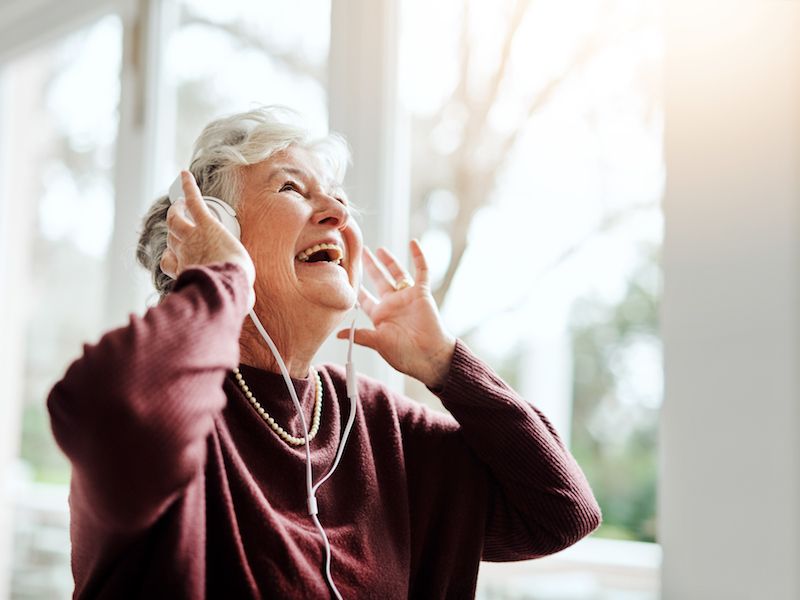
People who work in loud environments such as construction sites or at heavy metal concerts are not the only ones affected by noise related loss of hearing. Leisure related noise exposure can be just as harmful as work related noise exposure. What kind of exposure are we dealing with? Loud noise heard through headphones, whether it’s gaming, streaming video, music, or even an audiobook with the volume turned up.
You might be alarmed to discover that a mobile device can go that loud. The average pain threshold for human hearing is roughly 150 db which is well within the range of these devices. Your ears will literally start to hurt at this volume. So what’s the answer for safeguarding your ears against volume related injury.
It’s relevant here to think about the volume. Listen with the volume at no more than 60% for 60 minutes or less at a stretch (how long you listen for also makes a difference), this is called the 60/60 rule.
Your Hearing Aids Can be Set up For Listening to Music
Make sure, if you’re utilizing hearing aids, you don’t try to drown out other noises by cranking your streaming music up too loud. And there are much healthier ways to listen to music so ask us about that also. Hearing aids aren’t made to increase the quality of music like they do with voices so if really like music, you may have discovered this. While listening to music, we can most likely make a few adjustments to help improve the sound quality and reduce the feedback.
Choosing Headphones
When buying headphones there are numerous options, specifically if you use hearing aids. It may be a matter of personal choice, but there are some things you will want to consider there too.
Over-the-Ear Headphones
Over the ear headphones are becoming popular again but you most likely won’t find the old foam covered ear pieces that used to come with a walkman. They have a lot of options in style and color, are commonly endorsed by celebrities, and can be unexpectedly expensive. And these headphones go over the whole ear blocking out noise, unlike those old foam ones.
Main-stream perception is that these are less dangerous than in-ear headphones because the source of the sound is further away from your eardrum. But because the speakers are bigger they are usually capable of much higher volume. Noise cancellation can be a good thing as long as you’re not losing important sounds like an oncoming vehicle. With that being said, because they cancel out outside sound, you can normally reduce the volume of what you’re listening to so it’s not so loud that it will injure your hearing.
Earbuds
The normal earbuds that come with devices like iPhones are much maligned for their inferior quality of sound, although a lot of people still use them because hey, they were included with the phone. Particularly, with newer Apple phones, it’s just easier to use the earbuds that were provided with the device because it most likely won’t have a headphone jack.
Earbuds also don’t block out noise so the drawback is, you have a tendency to turn up the sound level. It’s commonly assumed that placing earbuds so close to your eardrum is the primary concern but it’s really the volume.
Noise Canceling Earbuds
More comfortable than ordinary earbuds, models with a round rubber tip are the choice of many because they help block outside noise. A seal that blocks outside noise from getting in is formed by the rubber tip which conforms to the shape of the ear. But these earbuds can also block out sounds you need to hear and loud volume is still the primary concern. And if you wear hearing aids, obviously these won’t work for you.
A number of pairs might need to be evaluated before you find headphones that work for you. Your expectations, acoustically, will differ depending on what kind of usage you normally give them. The significant thing is to seek out headphones that make it comfortable for you to enjoy at a safe sound level.
How to be Sure Your Hearing is Safeguarded
How can you be sure it’s safe? If you have a smartphone, you can get an app for that, you can download the National Institute for Occupational Safety and Health’s free Sound Level Meter app. There are other apps you can get, but research has found that the accuracy of these other apps is hit-and-miss (additionally, for whatever reason, Android-based apps have proven less precise). That prompted NIOSH to develop their own app. The app lets you measure outside sounds, but it’s also possible to measure the sound coming from your device’s speakers, so you will know exactly how much volume your ears are subjected to. You have to do a little work, but taking these kinds of preventative measures can help protect your hearing.